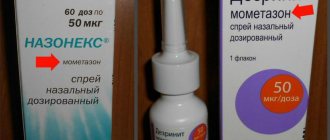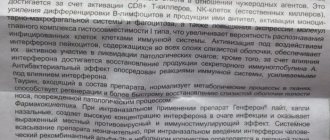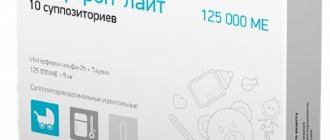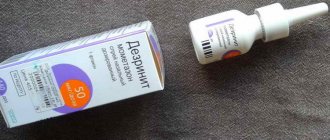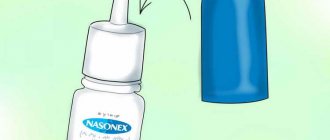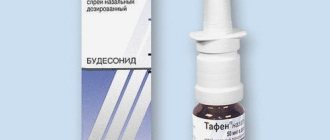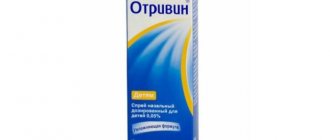Pharmacodynamics and pharmacokinetics
This drug exhibits an anti-inflammatory effect due to interaction with GCS receptors. In this case, there is a suppression of the proliferation of mast cells, lymphocytes, eosinophils, macrophages and neutrophils . Thanks to fluticasone propionate, there is a decrease in the production of inflammatory mediators and other biologically active components, for example: histamine, cytokines and leukotrienes , at the early and later stages of allergic reactions. As a result, the patient's response to bronchodilators is restored, allowing the frequency of their use to be reduced. The frequency of sneezing, itching in the nose decreases, a runny nose and nasal congestion, discomfort in the paranasal sinuses and a feeling of pressure on the nose and eyes are eliminated. In addition, eye symptoms related to allergic rhinitis .
The use of the spray has a rapid anti-inflammatory effect on the nasal mucosa 2-4 hours after the first injection.
Reduction in the severity of symptoms, mainly nasal congestion , can persist for at least a day after administration of a single dose.
The use of the drug in compliance with the recommended dosages does not cause the severity of its systemic activity and does not contribute to the suppression of the hypothalamic-pituitary-adrenal system.
Intranasal administration of the spray does not lead to detection of the drug in the blood plasma . This product is characterized by low absorption, since most of it is swallowed. The absorption of their gastrointestinal tract into the blood is only about 1% of the dose taken. However, fluticasone propionate undergoes rapid distribution and significant plasma protein binding. The drug is eliminated from the body quite quickly, mainly in the form of metabolites in the bile.
Flixonase spray naz.doz.50mkg/dose vial.60doses 184745
Description
Pharmacological action of FLIXONASE - gx for intranasal use. It has a pronounced anti-inflammatory, anti-edematous and anti-allergic effect. The anti-inflammatory effect is realized as a result of the interaction of the drug with glucocorticosteroid receptors. Suppresses the proliferation of mast cells, eosinophils, lymphocytes, macrophages, neutrophils. Fluticasone propionate reduces the production of inflammatory mediators and a number of biologically active substances (including histamine, prostaglandins, leukotrienes, cytokines) during the early and late phases of the allergic reaction. Has a rapid anti-inflammatory effect on the nasal mucosa. The antiallergic effect appears within 2-4 hours after the first use. Reduces sneezing, nasal itching, rhinorrhea, nasal congestion, discomfort in the sinuses and pressure around the nose and eyes. In addition, it relieves eye symptoms associated with allergic rhinitis. Reduction in the severity of symptoms (especially nasal congestion) persists for 24 hours after a single use of the spray at a dose of 200 mcg. Indications: prevention and treatment of seasonal allergic rhinitis; — prevention and treatment of year-round allergic rhinitis. Contraindications: children under 4 years of age; - hypersensitivity to fluticasone propionate and other components of the drug. Use during pregnancy and breastfeeding It is not recommended to prescribe Flixonase during pregnancy. If it is necessary to use the drug in this category of patients, the expected benefits of therapy for the mother and the potential risk for the fetus should be taken into account. Special instructions Caution must be exercised when transferring patients from systemic corticosteroid therapy to treatment with Flixonase if there is reason to suspect adrenal dysfunction. With long-term use of the drug, regular monitoring of adrenal function is required. The patient should be warned that if there is no improvement after 7 days of continuous use of the drug, he should consult a doctor. With continuous use of the drug for more than 6 months, medical monitoring of the patient's condition is necessary. In most cases, the use of Flixonase can successfully control the symptoms of seasonal allergic rhinitis, but in some cases, with very high concentrations of allergens in the air in the summer, additional therapy may be required. To relieve ophthalmological manifestations against the background of successful treatment of seasonal allergic rhinitis, additional treatment may be required. Side effects Local reactions: dryness and irritation of the nasopharynx, unpleasant taste and smell, nosebleeds, burning sensation, nasal congestion; very rarely (less than 1/10,000 cases) - perforation of the nasal septum (especially with a history of surgical interventions in the nasal cavity). Allergic reactions: possible skin rash, swelling of the face and tongue; very rarely (less than 1/10,000 cases) - anaphylactic reactions and bronchospasm. Other: headache. Very rare cases of glaucoma, increased intraocular pressure and cataracts have been reported with long-term use of fluticasone propionate, however, a cause-and-effect relationship was not identified in clinical studies lasting up to 1 year. Drug interactions Due to the very low plasma concentrations of fluticasone propionate after administration of Flixonase, a clinically significant interaction is unlikely. With simultaneous use of Flixonase with ritonavir, which is a strong inhibitor of the CYP3A4 isoenzyme, a significant increase in the concentration of fluticasone propionate in the blood plasma is possible. As a result, there is a sharp decrease in serum cortisol concentrations, and side effects due to the systemic action of corticosteroids develop, including Cushing's syndrome and suppression of adrenal function. With simultaneous use of Flixonase with other inhibitors of the CYP3A4 isoenzyme, a negligible (with erythromycin) or insignificant (with ketoconazole) increase in the concentrations of fluticasone propionate in the blood plasma is observed, which does not cause a noticeable decrease in serum cortisol concentrations. Overdose There are no symptoms of acute or chronic overdose of the drug. When administered intranasally to healthy volunteers, 2 mg of fluticasone propionate 2 times a day. within 7 days no effect on the function of the hypothalamic-pituitary-adrenal system was detected. Storage conditions The drug should be stored at a temperature not exceeding 30°C. Shelf life: 2 years.
Compound
1 dose: - fluticasone propionate (micronized) 50 mcg Excipients: anhydrous dextrose, microcrystalline cellulose, microcrystalline carboxymethylcellulose, phenylethyl alcohol, benzalkonium chloride solution, polysorbate 80, diluted hydrochloric acid, purified water.
Application
Flixonase is intended for intranasal use only. To achieve the full therapeutic effect, the drug should be used regularly. For the prevention and treatment of seasonal allergic rhinitis and year-round allergic rhinitis, adults and children over 12 years of age are prescribed 100 mcg (2 doses) in each nostril 1 time per day (total dose 200 mcg/day), preferably in the morning. After achieving control of symptoms, you can prescribe 50 mcg (1 dose) in each nostril 1 time / day (total dose 100 mcg / day). In some cases, it is necessary to use 100 mcg (2 doses) in each nostril 2 times / day (total dose 400 mcg / day) for a short time in order to achieve control of symptoms, after which the dose can be reduced. The maximum daily dose of the drug is 400 mcg (4 doses in each nostril). Elderly patients do not require dosage adjustment. For the prevention and treatment of seasonal allergic rhinitis, it is recommended that children aged 4-12 years be prescribed 50 mcg (1 dose) in each nostril 1 time/day. The maximum daily dose of the drug is 200 mcg (2 doses in each nostril). The maximum therapeutic effect appears after 3-4 days of therapy. To achieve the full therapeutic effect, it is necessary to use the drug regularly. Before use, carefully shake the bottle, take it by placing the index and middle fingers on either side of the tip, and the thumb under the bottom. When using the drug for the first time or a break in its use for more than 1 week, you should check the serviceability of the sprayer (pointing the tip away from you, make several presses until a small cloud appears from the tip). Next you need to: - clean your nose (blow your nose lightly); - close one nostril and insert the tip into the other nostril; — tilt your head slightly forward, continuing to hold the aerosol bottle vertically; - begin to inhale through your nose and, continuing to inhale, press once with your fingers to spray the drug; - exhale through your mouth. Repeat the procedure for a second spray in the same nostril, if necessary. Next, repeat the described procedure completely, inserting the tip into the other nostril. After use, blot the tip with a clean napkin or handkerchief and close it with the cap. The sprayer should be washed at least once a week. For this purpose, you must carefully remove the tip and rinse it in warm water. Shake off excess water and leave to dry in a warm place. Avoid overheating. Then carefully place the tip in its original place at the top of the brown bottle. Put on the protective cap. If the tip hole is clogged, the tip should be removed as described above and left in warm water for a while. Then rinse under running cold water, dry and put back on the bottle. Do not clean the tip hole with a pin or other sharp objects.
Flixonase spray instructions for use (Method and dosage)
Detailed instructions for use of Flixonase recommend administering it intranasally. For patients over 12 years of age, the drug is prescribed for the prevention and treatment of various forms of allergic rhinitis. In this case, the medicine must be injected 2 times into each nasal passage 1-2 times a day. Once control of symptoms is achieved, the dosage is reduced to one administration once a day.
In this case, the maximum permissible daily dosage of Flixonase is up to 4 injections.
For pediatric patients aged 4-12 years, during preventive measures and treatment of rhinitis, the drug can be injected once a day into each nasal passage.
Regular use of the drug contributes to achieving the full therapeutic effect. It has been established that these nasal drops do not exhibit an immediate therapeutic effect; this usually occurs after 3-4 days from the start of use.
Flixonase™ drug overdose, symptoms and treatment
Symptoms of acute or chronic overdose are not described. Intranasal administration of fluticasone propionate to healthy volunteers at a dose of 2 mg 2 times a day for 7 days did not affect the function of the hypothalamic-pituitary-adrenal system. Long-term use of large doses may lead to temporary suppression of adrenal function. In such patients, treatment with fluticasone propionate should be continued at doses sufficient to control symptoms. Adrenal function will recover in a few days, which can be checked by determining the level of cortisol in the blood plasma.
special instructions
This drug can only be used intranasally, with a treatment duration of up to 6 months. If treatment continues longer than this period, then monitoring of the activity of the adrenal cortex is required.
The full effect of the spray appears only after a few days of use, so you should adhere to a regular therapeutic regimen.
Usually, for most patients, this drug is enough to eliminate the signs of seasonal allergic rhinitis, but sometimes additional treatment may be required, for example, to relieve ophthalmic manifestations.
Dosage regimen
Flixonase is intended for intranasal use only. To achieve the full therapeutic effect, the drug should be used regularly.
Adults and children over 12 years old
Prescribe 100 mcg (2 doses) in each nostril 1 time / day. (total dose 200 mcg/day), preferably in the morning. After achieving control of symptoms, you can prescribe 50 mcg (1 dose) in each nostril 1 time / day. (total dose 100 mcg/day).
In some cases, it is necessary to apply 100 mcg (2 doses) in each nostril for 2 days. (total dose 400 mcg/day) for a short time in order to achieve control of symptoms, after which the dose can be reduced. The maximum daily dose of the drug is 400 mcg (4 doses in each nostril).
Elderly patients
no dosage regimen adjustment is required.
Children aged 4-12 years
It is recommended to administer 50 mcg (1 dose) in each nostril 1 time/day. The maximum daily dose of the drug is 200 mcg (2 doses in each nostril).
The maximum therapeutic effect appears after 3-4 days of therapy. To achieve the full therapeutic effect, it is necessary to use the drug regularly.
Mode of application
Before use, shake the bottle carefully, take it by placing your index and middle fingers on either side of the tip, and your thumb under the bottom. When using the drug for the first time or a break in its use for more than 1 week, you should check the serviceability of the sprayer (pointing the tip away from you, make several presses until a small cloud appears from the tip).
Next you need:
- clear your nose (blow your nose lightly);
- close one nostril and insert the tip into the other nostril;
— tilt your head slightly forward, continuing to hold the aerosol bottle vertically;
- begin to inhale through your nose and, continuing to inhale, press once with your fingers to spray the drug;
- exhale through your mouth.
Repeat the procedure for a second spray in the same nostril, if necessary. Next, repeat the described procedure completely, inserting the tip into the other nostril.
After use, blot the tip with a clean napkin or handkerchief and close it with the cap.
The sprayer should be washed at least once a week. For this purpose, you must carefully remove the tip and rinse it in warm water. Shake off excess water and leave to dry in a warm place. Avoid overheating. Then carefully place the tip in its original place at the top of the brown bottle. Put on the protective cap. If the tip hole is clogged, the tip should be removed as described above and left in warm water for a while. Then rinse under running cold water, dry and put back on the bottle. Do not clean the tip hole with a pin or other sharp objects.
Flixonase analogs
Level 4 ATC code matches:
Nazophan
Nazarel
Nasonex
Beclomethasone
Tafen Nazal
Nasobek
Polydexa with Phenylephrine
Avamis
Baconase
Benarin
The main analogues of Flixonase: Nazarel, Nasonex and Fluticasone .
Side effects of Flixonase™
Immune system disorders Very rare: hypersensitivity reactions, anaphylaxis/anaphylactic reactions, bronchospasm, skin rashes, swelling of the face or tongue. From the nervous system : often: headache, unpleasant taste and smell. On the part of the organ of vision Very rarely: glaucoma, increased intraocular pressure, cataracts. From the respiratory system and chest organs Very often: nosebleeds. Common: dryness and irritation of the mucous membrane of the nasal cavity and throat. Very rare: perforation of the nasal septum.
Reviews about Flixonase
Many reviews about this drug can be found on various forums, the topics of which are devoted to the treatment of allergic rhinitis. Users also actively discuss ways to prevent this disorder and the effectiveness of other drugs with a similar effect.
Quite often, patients leave reviews of Flixonase as an effective drug that brings great relief in the manifestations of allergic rhinitis. However, some users report that the treatment did not bring complete recovery. For example, even using the spray for a month did not help eliminate swelling and completely restore the sense of smell.
In addition, there are descriptions of cases of intolerance to the drug, which were manifested by severe swelling, copious watery discharge and even greater nasal congestion.
Users are also actively discussing the topic of possible interchangeability of drugs, which medicines for allergic rhinitis are the most effective, how safe they are, how comfortable they are to use, and so on.
As for Flixonase, reviews from doctors only confirm its high effectiveness. At the same time, they once again note that it can be used according to indications, with a definitively clarified diagnosis. It is important to follow the dosage, regimen and other features of administration. Only in this case can one expect a good treatment outcome, without complications and side effects.
Interactions of the drug Flixonase™
Given the very low plasma concentrations of fluticasone propionate after intranasal administration due to extensive first-pass metabolism in the liver and high systemic clearance of the drug due to cytochrome P450 3A4 in the liver and intestine, a clinically significant interaction is unlikely. With simultaneous use of Flixonase with ritanavir (a strong inhibitor of cytochrome P450 3A4) it can significantly increase the concentration of fluticasone propionate in plasma, which leads to a significant decrease in the concentration of cortisol in the blood serum, side effects due to the systemic action of corticosteroids develop, including Cushing's syndrome and suppression of adrenal cortex function . Therefore, it is necessary to avoid the simultaneous use of fluticasone propionate and ritanavir, except in cases where the benefits of use will outweigh the risk of systemic effects of corticosteroids. Concomitant use of Flixonase with other cytochrome P450 3A4 inhibitors leads to a slight (erythromycin) or small (ketoconazole) effect on increasing the systemic concentration of fluticasone propionate in the blood serum without a significant decrease in cortisol concentration. However, with the simultaneous use of fluticasone propionate and strong inhibitors of cytochrome P450 3A4 (for example, ketoconazole), caution must be exercised, given the possibility of increased systemic exposure to fluticasone propionate.
Flixonase price, where to buy
The price of Flixonase spray varies between 730-780 rubles.
- Online pharmacies in RussiaRussia
ZdravCity
- Flixonase Flixonase for allergic rhinitis, nasal spray, 50 mcg/dose, 120 dosesGlaxo Wellcome SA
RUB 736.order - Flixonase Flixonase for allergic rhinitis, nasal spray, 50 mcg/dose, 60 dosesGlaxo Wellcome SA
440 rub. order
Contraindications to the use of the drug FLIXONASE
- children under 4 years of age;
- hypersensitivity to fluticasone propionate and other components of the drug.
Carefully _
The drug should be used if you have herpes, as well as an infection of the nasal cavity or paranasal sinuses.
Infectious diseases of the nose require appropriate treatment. Infectious diseases of the nose are not a contraindication for the use of Flixonase .
Carefully _
the drug should be prescribed after a recent injury to the nose or after surgery in the nasal cavity, as well as in the presence of ulcerative lesions of the nasal mucosa.
Carefully _
Flixonase should be prescribed simultaneously with inhibitors of the CYP3A4 isoenzyme (including ritonavir, ketoconazole), since these drugs can cause an increase in the concentration of fluticasone propionate in plasma.
Carefully _
The drug should be prescribed concomitantly with other dosage forms of corticosteroids, including tablets, creams, ointments, asthma medications, similar nasal sprays, and eye or nasal drops.
Instructions for use with dosage
To treat rhinitis, Flixonase is injected into the nostrils. One procedure is performed per day in the form of 2 sprays, it is advisable to resort to it in the morning. For children over 4 years of age, the dosage is reduced by 2 times.
The manipulation begins with clearing the nose and then:
- Shake the bottle with liquid.
- The head is tilted slightly forward.
- Having closed one passage, insert the dispenser tip into the other.
- When inhaling, spray the spray.
- Exhale through the mouth.
To prevent germs from accumulating in the device, it must be washed after each use. The bottle is tightly closed with a cap.
The dose of the drug should not exceed 200 mcg.
Compound
Fluticasone propionate, which serves as the active component of Flixonase, prevents the synthesis of cells that take part in the pathological process provoked by allergens. The spray for allergic rhinitis contains additional substances in the form of:
- cellulose;
- polysorbate;
- hydrochloric acid;
- phenylethyl alcohol.
The concentration of the active component in the product is insignificant, so the spray does not have a systemic effect on the entire body. A small part of the substances that enter the digestive tract is removed from the plasma very quickly and is unable to cause harm.
How to take Allergodil for allergies, read the link.
